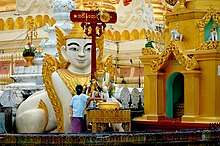Chinthe
The chinthe (Burmese: ခြင်္သေ့; MLCTS: hkrang se., IPA: [tɕʰɪ̀ɰ̃ðḛ]; Mon: ဇာဒိသိုၚ်, [cɛ̀atìʔsaŋ]; Shan: သၢင်ႇသီႈ, [sàːŋ si]) is a highly stylized leogryph (lion-like creature) commonly depicted in Burmese iconography and Myanmar architecture, especially as a pair of guardians flanking the entrances of Buddhist pagodas and kyaung (or Buddhist monasteries). The chinthe is featured prominently on most paper denominations of the Burmese kyat. A related creature, the manussiha, is also commonly depicted in Myanmar.[1] In Burmese, chinthe is synonymous with the Burmese word for "lion."

The chinthe is related to other leogryphs in the Asian region, including the sing (สิงห์) of Thailand, Cambodia, Laos, and the simha (සිංහ) of Sri Lanka, where it is featured prominently on the Sri Lankan rupee. It is also related to East Asian leogryphs, such as the guardian lions of China, komainu of Japan, shisa of Okinawa and Snow Lion of Tibet.
Origins
.svg.png)
The story of why chinthes guard the entrances of pagodas and temples is given as such from the Mahavamsa:
The princess Suppadevi of Vanga Kingdom (Present day Bengal) had a son named Sinhabahu through her marriage to a lion, but later abandoned the lion who then became enraged and set out on a road of terror throughout the lands. The son then went out to slay this terrorizing lion. The son came back home to his mother stating he slew the lion, and then found out that he killed his own father. The son later constructed a statue of the lion as a guardian of a temple to atone for his sin.[2]
In Burmese culture

The chinthe is symbolically used as an element of Burmese iconography on many revered objects, including the palin, the Burmese royal thrones and Burmese bells. Predating the use of coins for money, brass weights cast in the shape of mythical beasts like the chinthe were commonly used to measure standard quantities of staple items.[3] In the Burmese zodiac, the chinthe (lion) sign is representative of Tuesday-born individuals.
 A series of chinthes flank the rooftop at Bagan's Ananda Temple.
A series of chinthes flank the rooftop at Bagan's Ananda Temple. A pair of whitewashed chinthe guard the entrance to Mandalay Hill.
A pair of whitewashed chinthe guard the entrance to Mandalay Hill..jpg) A series of chinthe surround the circumference of the Independence Monument in Yangon.
A series of chinthe surround the circumference of the Independence Monument in Yangon. Chinthe are commonly depicted atop Burmese bells, including atop the Mingun Bell.
Chinthe are commonly depicted atop Burmese bells, including atop the Mingun Bell. A close-up of chinthe head, Ananda Temple.
A close-up of chinthe head, Ananda Temple.
Manussiha

The manussiha (Burmese: မနုဿီဟ manothiha, Shan: မၼုၵ်ႉသီႇႁႃႉ manuk siha), a combination of Pali manussa (man) and siha (lion) is a half-lion half-man mythical creature that is symbolic of a guardian, usually found guarding the four corners of a pagoda. It has a human head and torso and lion hindquarters.[4] It is comparable to the sphinx and Hindu deity Narasimha.
Relation to Second World War Chindits
During the Second World War, the British Brigadier Orde Wingate was given command of forces charged with long-range penetration operations behind Japanese lines in Burma. At the suggestion of Captain Aung Thin of the Burma Rifles, Wingate decided to call this force "The Chinthes" - a name which became corrupted to "The Chindits" and is as such remembered in the annals of World War II.
See also
| Wikimedia Commons has media related to Chinthe. |
References
- "Shwedagon Paya, Rangoon". www.art-and-archaeology.com. Retrieved 2019-12-27.
- "Image 5 of 20". myanmar-image.com. Archived from the original on 2017-04-11. Retrieved 2010-09-17.
- Shwechinthe Birmans
- "Archived copy". Archived from the original on 2009-02-27. Retrieved 2010-06-19.CS1 maint: archived copy as title (link)